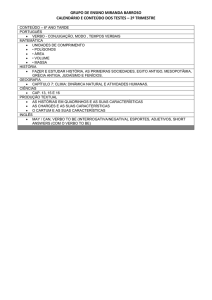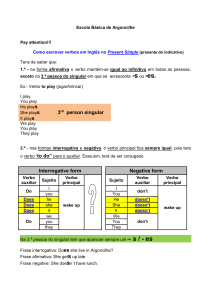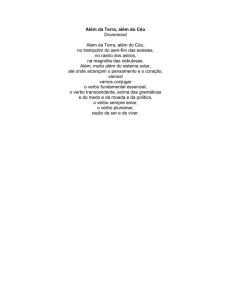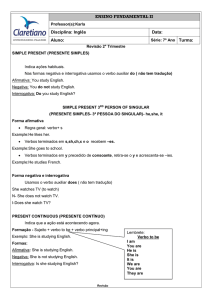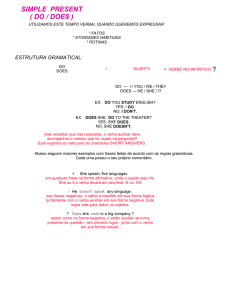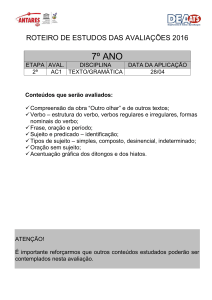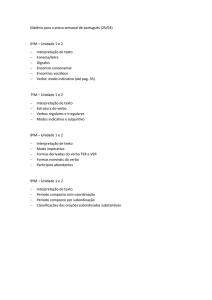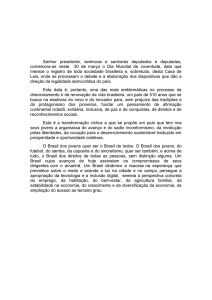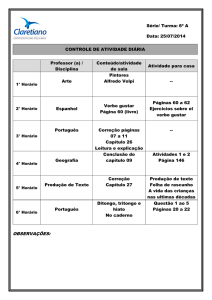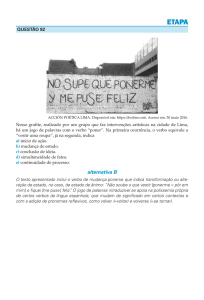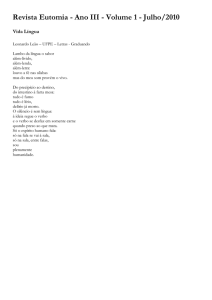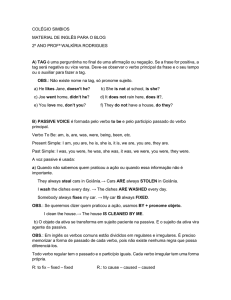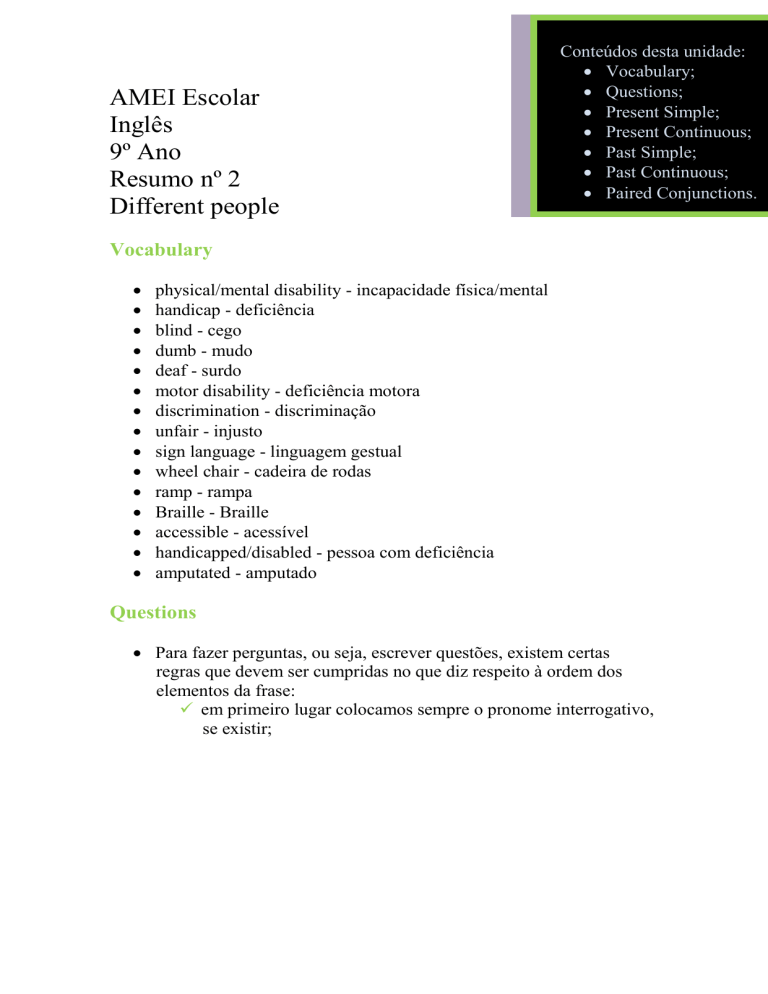
AMEI Escolar
Inglês
9º Ano
Resumo nº 2
Different people
Conteúdos desta unidade:
Vocabulary;
Questions;
Present Simple;
Present Continuous;
Past Simple;
Past Continuous;
Paired Conjunctions.
Vocabulary
physical/mental disability - incapacidade física/mental
handicap - deficiência
blind - cego
dumb - mudo
deaf - surdo
motor disability - deficiência motora
discrimination - discriminação
unfair - injusto
sign language - linguagem gestual
wheel chair - cadeira de rodas
ramp - rampa
Braille - Braille
accessible - acessível
handicapped/disabled - pessoa com deficiência
amputated - amputado
Questions
Para fazer perguntas, ou seja, escrever questões, existem certas
regras que devem ser cumpridas no que diz respeito à ordem dos
elementos da frase:
em primeiro lugar colocamos sempre o pronome interrogativo,
se existir;
Questions words - pronomes interrogativos:
what? - o quê/qual?
who? - quem?
when? - quando?
how? - como?
where? - onde?
why? - porquê?
how old? - que idade?
how long? - quanto tempo?
how far? - a que distância?
how many/much? - quanto/s?
how many times? - quantas vezes?
how often? - com que frequência?
coloca-se primeiro o verbo auxiliar, seguido do nome e só
depois o verbo principal. Assim sendo, o verbo auxiliar é
aqule que reflecte o tempo da pergunta. Em verbos que não
necessitem de verbo auxiliar coloca-se simplesmente o verbo
antes do nome;
pronome interrogativo verbo auxiliar sujeito verbo principal no infinitivo … ?
Where did Mariana go in her holidays?
Who did Mariana meet in Spain?
pronome interrogativo verbo principal no tempo da pergunta sujeito … ?
What was the thing she most like to do in Spain?
nas perguntas em que o sujeito é a resposta, ou seja, não existe
sujeito, a ordem das palavras é, obviamente diferente: depois
do pronome interrogativo vem o verbo principal no tempo da
pergunta.
pronome interrogativo verbo principal no tempo da pergunta … ?
Who liked to spend time in the beach?
Como escrever a pergunta a partir da resposta?
Mariana spent her holidays in Spain.
1 - Olhamos para a partícula da frase que nos dá definitivamente a resposta. Neste caso é
“in Spain”. Com esta partícula conseguimos determinar qual o pronome interrogativo
utilizado, que neste caso, é “Where”.
2 - Olhamos para o verbo e para o tempo e aplicamos a ordem correcta das partículas
numa frase colocando primeiro o verbo auxiliary, neste caso, no passado, depois o sujeito
(“Mariana”) e por fim o verbo no infinitivo, que neste caso é “spend”.
3 - Por fim colocamos o resto da frase que ainda não analizamos (“her holidays”) e
terminamos com o devido sinal de pontuação: ?.
Where did Mariana spend her holidays?
Present Simple
O presente simples usa-se para falar de rotinas diárias, hábitos e
estados permanentes e utiliza-se com os seguintes advérbios de
frequência e expressões:
always - sempre
usually - usualmente
often - muitas vezes
sometimes - algumas vezes
rarely - raramente
never - nunca
every day - todos os dias
...
Present Simple of the Verb Write
Affirmative
Negative
Interrogative
I write
I don’t write
Do I write?
You write
You don’t write
Do you write?
He/she/it writes He/she/it doesn’t write Does he/she/it write?
We write
We don’t write
Do we write?
You write
You don’t write
Do you write?
They write
They don’t write
Do they write?
Affirmative:
Para formar o presente, regra geral, utilizamos a forma verbal igual
ao infinitivo, menos na terceira pessoa do singular (he, she, it):
Caso
regra geral
verbos que terminam em consoante
+ -y
verbos que terminam em vogal + -y
verbos que terminam em -ss, -x, -o,
-ch
Resultado
acrescenta-se -s
mudam o -y para -i e só
depois acrescenta-se -es
seguem a regra geral
acrescenta-se -es
Exemplos
sing sings
cry cries
say says
fix fixes
pass passes
watch watches
do does
Negative/Interrogative:
Para formar a negativa utiliza-se sempre o verbo auxiliar do no
presente e na negativa e o verbo principal no infinitivo. A marca da
terceira pessoa passa, igualmente, para o verbo auxiliar.
I don’t go to the school at the Saturdays. / She doesn’t like potatoes.
Para formar a interrogativa utiliza-se sempre o verbo auxiliar do no
presente e na interrogativa e o verbo principal no infinitivo. A marca
da terceira pessoa passa, igualmente, para o verbo auxiliar.
Do I go to the school at the Saturdays? / Does she like potatoes?
Present Continuous
O presente contínuo usa-se para falar sobre o que está a acontecer no
momento em que se fala, sobre uma situação temporária ou sobre um
futuro próximo e imediato e utiliza-se com os seguintes advérbios de
frequência e expressões:
now - agora;
at the moment - neste momento;
today - neste dia;
...
Present Continuous of the Verb Work
Affirmative
Negative
Interrogative
I am working
I’m not working
Am I working?
You are working
You aren’t working
Are you working?
He/she/it is working He/she/it isn’t working Is he/she/it working?
We are working
We aren’t working
Are we working?
You are working
You aren’t working
Are you working?
They are working
They aren’t working
Are they working?
Affirmative:
Forma-se com o verbo auxiliar TO BE no presente mais o verbo
principal com a terminação -ing:
Caso
regra geral
verbos terminados em consoante +
vogal + consoante
verbos terminados em -e
Resultado
acrescenta-se -ing
normalmente duplicam a
consoante final
retira-se o -e e acrescentase -ing
Exemplos
do doing
run running
forget forgetting
write writing
make making
Negative/Interrogative:
Forma-se segundo as regras do Present Simple do verbo auxiliar,
mantendo-se o verbo principal com a terminação -ing.
I’m not studying in the pool. /Are you dancing with my friend?
Past Simple
O passado simple usa-se para falar de um acontecimento que
começou e acabou no passado e utiliza-se com as seguintes
expressões de tempo:
yesterday - ontem
last week/summer/... - na semana/verão/... passado(a)
two weeks/six months/... ago - à duas semanas/seis meses/...
atrás
in 2000/1996/... - em 2000/1996/...
when I was 10/I lived in Spain/... - quando eu tinha dez
anos/vivia em Espanha/...
Past Simple of the Verb Talk
Affirmative
Negative
Interrogative
I talked
I didn’t talk
Did I talk?
You talked
You didn’t talk
Did you talk?
He/she/it talked
He/she/it didn’t talk
Did she/he/it talk?
We talked
We didn’t talk
Did we talk?
You talked
You didn’t talk
Did you talk?
They talked
They didn’t talk
Did they talk?
Affirmative:
Para formar o passado acresenta-se, geralmente, -ed ao verbo:
Caso
regra geral
Resultado
acrescenta-se -ed
verbos terminados em -e
acressenta-se somente o -d
verbos terminados em consoante +
duplica-se a consoante
final e acrescenta-se -ed
vogal + consoante
verbos terminados em consoante +
o -y passa a -i,
-y
acrescentando-se depois ed
verbos irregulares
têm diferentes terminações
Exemplos
talk talked
hunt hunted
arrive arrived
plan planned
stop stopped
study studied
do did
be was/were
swim swam
(consulta a ficha de
apoio)
Negative/Interrogative:
Para formar a negativa utiliza-se sempre o verbo auxiliar do no Past
Simple e na negativa e o verbo principal no infinitivo.
I didn’t have swimming last year. /She didn’t go to the school yesterday.
Para formar a interrogativa utiliza-se sempre o verbo auxiliar do no
Past Simple e na interrogativa e o verbo principal no infinitivo.
Did I have swimming last year? /Did she go to the school yesterday?
Past Continuous
O passado contínuo usa-se para falar de acções que aconteceram num
tempo específico do passado (que ainda não tinham terminado),
quando estão duas actividades a decorrer ao mesmo tempo no
passado e quando uma acção estava a decorrer e outra aconteceu e
usa-se com as seguintes conjunções:
when - quando
while - enquanto
as - quando
Present Continuous of the Verb Study
Affirmative
Negative
Interrogative
I was studying
I wasn’t studying
Was I studying?
You were studying
You weren’t studying
Were you studying?
He/she/it was studying He/she/it wasn’t studying Was he/she/it studying?
We were studying
We weren’t studying
Were we studying?
You were studying
You weren’t studying
Were you studying?
They were studying
They weren’t studying
Were they studying?
Affirmative:
Forma-se com o verbo auxiliar TO BE no passado mais o verbo
principal com a terminação -ing:
Caso
regra geral
verbos terminados em consoante +
vogal + consoante
verbos terminados em -e
Resultado
acrescenta-se -ing
normalmente duplicam a
consoante final
retira-se o -e e acrescentase -ing
Exemplos
do doing
run running
forget forgetting
write writing
make making
Negative/Interrogative:
Forma-se segundo as regras do Present Simple do verbo auxiliar,
mantendo-se o verbo principal com a terminação -ing.
I wasn’t playing football at the park. /Were you watching television last night?
Paired Conjunctions
A conjunções emparelhadas são expressões que servem para juntar
nomes, verbos e outras expressões, ligando frases. São elas
both ... and - tanto ... como
either ... or - ou ... ou
neither ... nor - nem ... nem
not only ... but also - não só ... mas também
Both Linda and Sarah are my friends.
Either Maria goes to the Sarah’s house or stay in the Barbara’s house.
I am neither in my house nor in the school.
Max is not only smart but also funny.
Estas expressões podem:
acrescentar qualidades e outras (“not only ... but also” “both ...
and”);
excluir (“neither ... nor”) ou alternar informação (“either ...
or”).
Se a frase for negativa não se utiliza a expressão “neither ... nor” pois
assim estamos numa situação de dupla negativa.
I neither will go to the music concert nor to the cinema
I will not going neither to the music concert nor to the cinema.
I will not going either to the music concert or to the cinema.
I neither will go to the music concert nor to the cinema.

